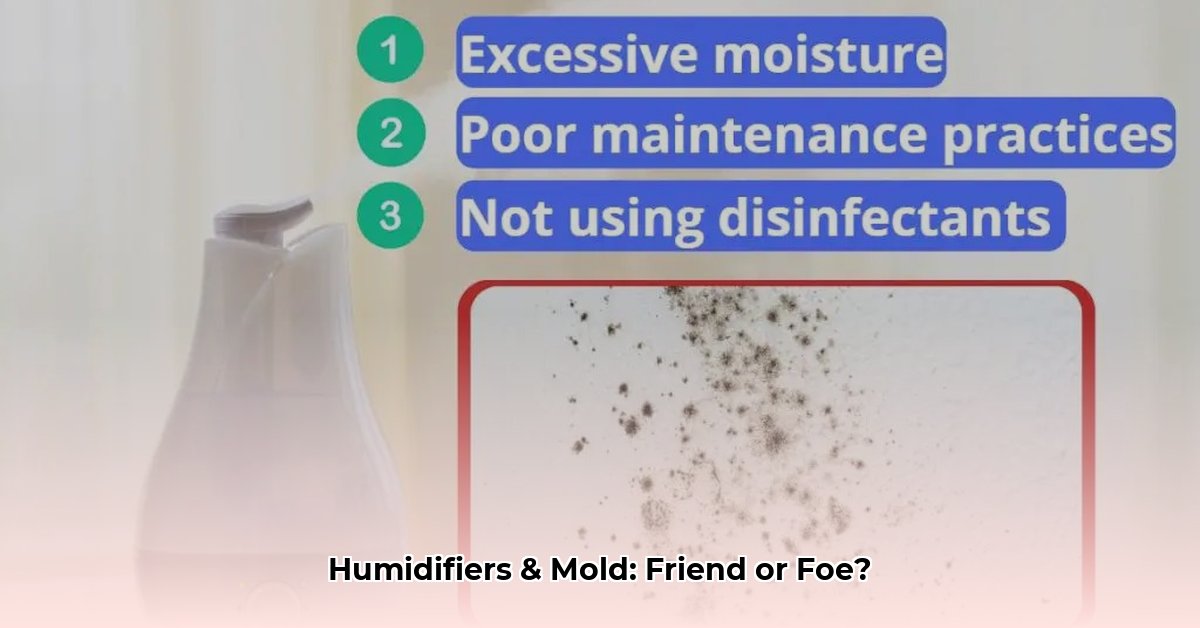Humidifiers offer much-needed relief from dry air, but concerns about mold often accompany their use. This comprehensive guide clarifies the relationship between humidifiers and mold, offering practical advice on prevention, cleaning, and troubleshooting.
Understanding the Mold-Humidity Connection
Humidifiers don’t inherently cause mold; they don’t spontaneously generate it. Rather, they can create an environment conducive to mold growth if not used and maintained correctly. Like tiny seeds, mold spores are ubiquitous in the air, waiting for favorable conditions to germinate. A poorly maintained humidifier, with its stagnant water and potential for mineral buildup, can unfortunately provide the ideal breeding ground. This is especially true if humidity levels exceed the EPA’s recommended range of 30-50%. Above 60% humidity, the risk of mold growth significantly increases.
Mold and Your Health
Mold exposure can trigger various health issues, ranging from mild allergies—stuffy nose, sneezing, itchy eyes—to more severe respiratory problems, especially for those with asthma or weakened immune systems. Certain molds produce mycotoxins, potentially exacerbating existing health conditions. While research continues to explore the full spectrum of mold’s health effects, it’s prudent to minimize exposure.
Identifying Mold in Your Humidifier
A musty odor is often the first sign of mold growth. Visible mold, appearing as black, green, pink, or white patches, confirms its presence. A slimy film inside the tank is another indicator. Worsening allergy symptoms when the humidifier is running also suggests a potential mold problem.
Preventing Mold Growth: A Proactive Approach
Preventing mold is far simpler than remediation. Here’s how to keep your humidifier mold-free:
Choosing the Right Humidifier
Some humidifier types are inherently more resistant to mold. Look for models with antimicrobial features or those made from mold-resistant materials. However, even these require diligent cleaning.
Using Purified Water
Distilled or demineralized water, devoid of minerals that mold feeds on, is crucial. Tap water contributes to both mold growth and mineral buildup, hindering humidifier performance.
Cleaning and Maintenance: A Step-by-Step Guide
Regular cleaning is paramount. Aim for a weekly deep clean and daily rinsing.
Daily:
- Empty the tank completely.
- Rinse with clean water.
- Wipe dry before refilling.
Weekly:
- Unplug the humidifier.
- Empty and rinse the tank.
- Fill the tank with white vinegar or a 3% hydrogen peroxide solution. Let it sit for 20-30 minutes. A diluted bleach solution (follow manufacturer instructions) is another option.
- Scrub all surfaces with a soft brush, targeting hard-to-reach areas.
- Rinse thoroughly with clean water and air dry completely.
Controlling Humidity
Maintain humidity levels between 30-50% using a hygrometer.
Ensuring Proper Ventilation
Good airflow inhibits mold growth. Open windows occasionally or use a fan to circulate air.
Additional Preventative Measures
- Consider using humidifier tablets or a few drops of tea tree oil (check manufacturer instructions for compatibility) to further deter mold.
- Adding a splash of white vinegar to the water during regular use can also help prevent mold.
Cleaning a Moldy Humidifier
If mold is present, follow the weekly cleaning steps, being extra thorough with scrubbing and disinfecting. Wear gloves and a mask. For severe infestations, consider replacing the humidifier.
Troubleshooting Common Issues
Mineral Buildup: Use distilled water and clean regularly.
Leaks: Check for cracks or loose connections. Consult your user manual.
Unusual Noises: Refer to your user manual or contact the manufacturer.
Beyond the Humidifier: Holistic Indoor Air Quality
Dehumidifiers, air purifiers, and mold testing kits can complement your mold prevention efforts. For significant mold problems, consult a professional mold remediation service.
FAQ
Q: Can humidifiers cause mold on walls?
A: Yes, if humidity levels are consistently too high.
Q: Which humidifier type is least prone to mold?
A: Evaporative humidifiers are generally considered less susceptible, but all types require proper maintenance.
Q: Can I add essential oils to my humidifier?
A: Check your manufacturer’s instructions. Some oils can damage the unit.
By following these guidelines, you can enjoy the benefits of a humidifier while mitigating the risks of mold, ensuring a healthier home environment.
- How to Stop Apps From Running in the Background to Boost Your - December 1, 2025
- How To Move Apps On Your Droid For Better Organization - November 30, 2025
- How to Move Apps on Android for Better Organization - November 29, 2025










